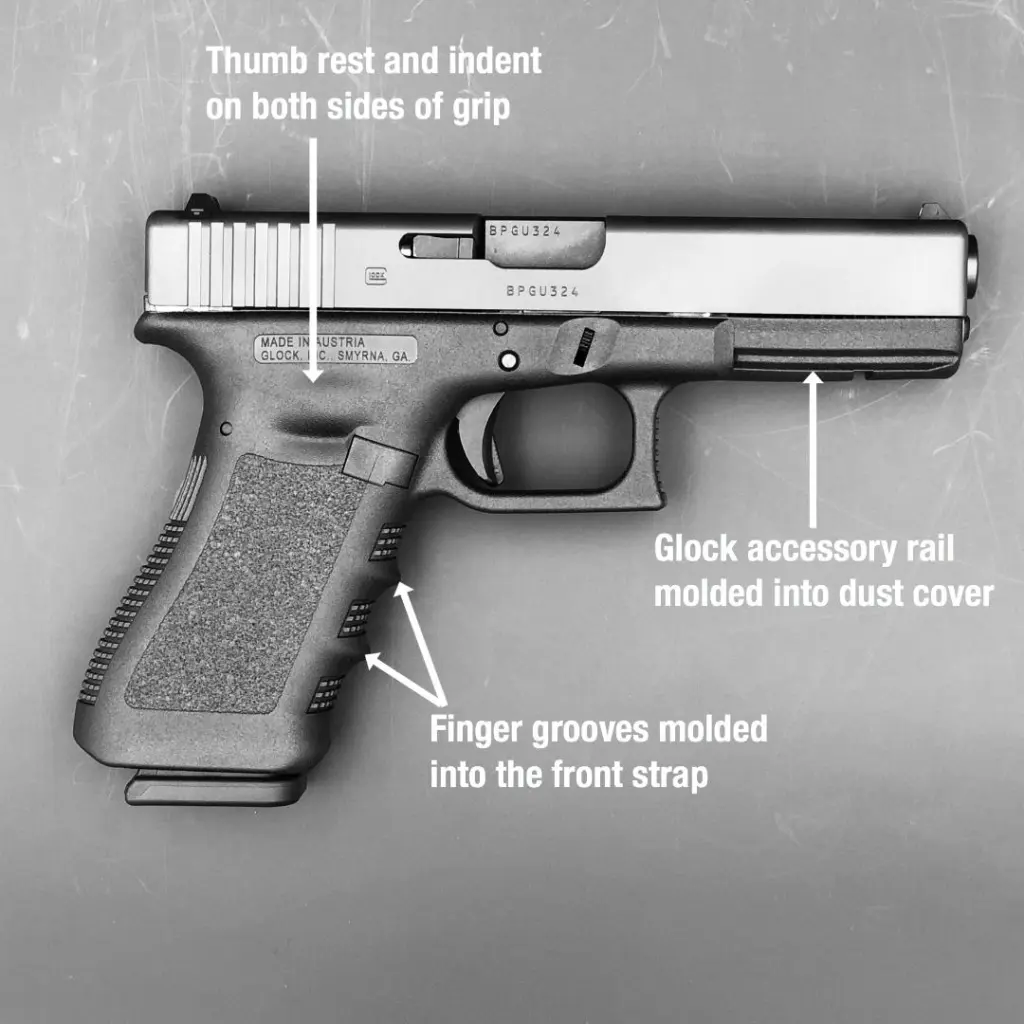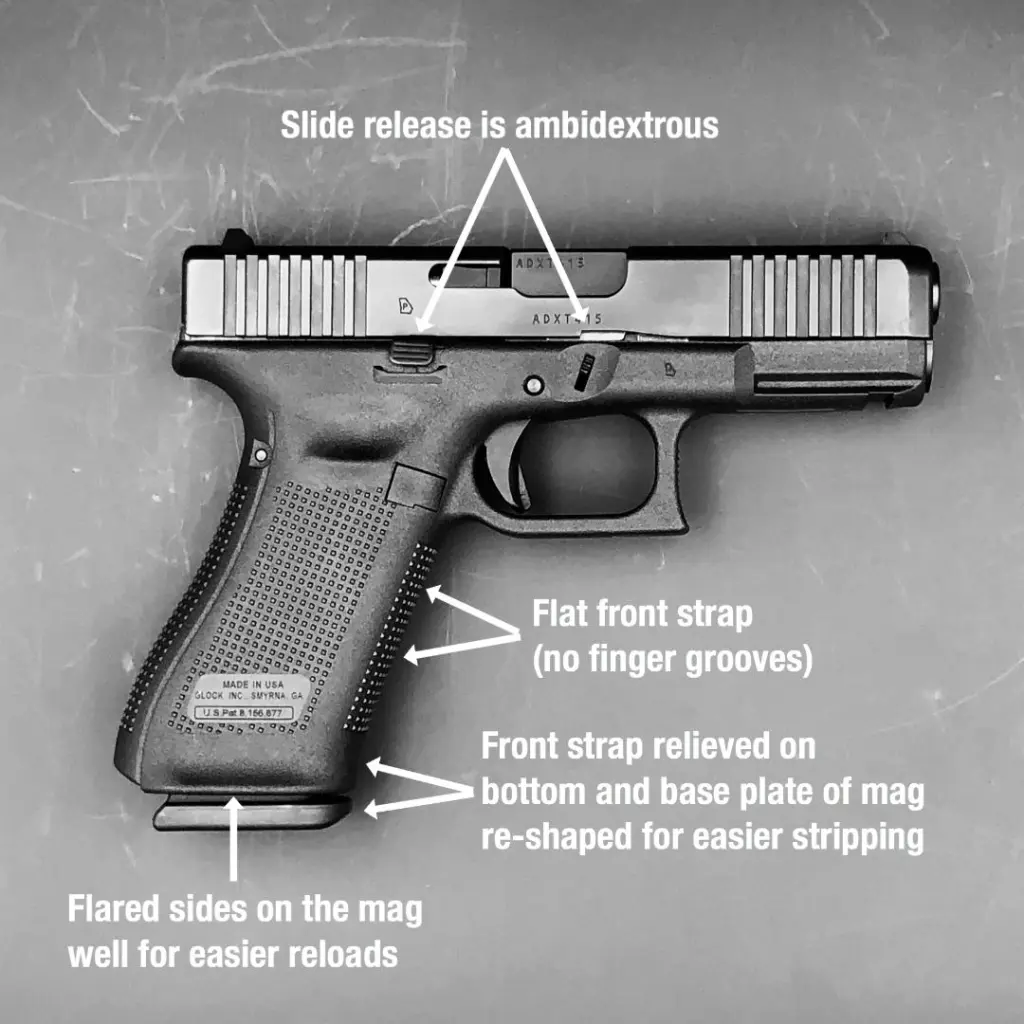How Do You Know What Gen Is on Glock
Let's clear up the confusion…
A very mutual question for new Glock buyers is "What Gen is my Glock?" Prior to the release of the 4th generation, Glock did not officially recognize any more than model numbers, contributing to the notion that "A Glock is a Glock is a Glock–They're nevertheless." Only early on collectors noticed the differences and informally settled on three major iterations, or "generations," by which to classify. The nomenclature became and so mutual that Glock followed suit with the release of Gen 4 in 2008 and their promotional literature now highlights earlier Gens in some places.
The pics below will assist you clearly identify which generation your Glock is a part of, but annotation that at that place is a great deal of overlap as models were transitioned slowly. As well, 3rd gen guns are still in production due to California's handgun restrictions so you could take a gen 5 gun that is actually older than your gen iii! The notes on the pics identify the major characteristics that are consistent throughout the generation, but small changes to markings and internal parts can be found at different intervals–and sometimes back and forth–within the same Gen. Thus the difficult breaks between generations only designate pregnant frame revisions, with many parts existence interchangeable across two or more than, but some changes merely lasting through a brusk run within a generation.
Gen 1

Click here for further breakup
The 1st generation was ane of constant change. The initial design, while reliable, was still under development. Early on guns featured a slimmer barrel that was stainless steel without the after parkerized finish. Several variations be in magazine, case, and minor internal parts. All guns will have Austrian proof marks, but non consistent placement or number of marks. Very early on (pre-Usa) guns also do not take a serial number plate in the frame. Near early guns were also fitted with target sights that have come up to exist called "Weakend Sights" considering of their fragility. Standard (fixed) sights are also menstruum correct, though the target version volition fetch a premium. All frames had a half-moon mag well relief in the bottom of the front end straps except the few 19s that were made.
| Models | 17-19 |
| Product Span | 1982-1988 |
| Calibers | ix×19, 9×21 |
| Common Characterics | Pebblestone Texture |
| 2-pivot Design | |
| Smooth Grit Embrace | |
| Mag Well Relief |
Gen 2

The 2nd Gen is what many novice collectors or even un-informed dealers will refer to as a "Gen i." The confusion stems from 2 factors: i. 1st Gens are very rare and non anybody has seen ane before. two. Many models were introduced in the 2nd Gen line and some consider them to exist "1st Gen" because it is the first issue of that particular model. The clear distinguisher between 1 and 2 is the checkering added to the front and dorsum strap also every bit the change to the texture of the side panels (deeper than the 1st Gen). Gen 2 likewise saw the introduction of 5 additional calibers and all non-.380/9mm guns were fitted with a second locking cake pin to prevent frame cracking from heavier recoil. Full size frames carried over the mag well relief at the bottom of the front end strap.
| Models | 17-33 |
| Production Span | 1988-1998 |
| Calibers | 9×19, 9×21, .357 SIG, .forty South&Due west, 10mm, .45 ACP |
| Common Characterics | Side Grip "Panels" |
| Checkered Front/Dorsum Strap | |
| Smooth Dust Comprehend | |
| Mag Well Relief |
Gen three

By the tardily '90s, Glock had become a dominant strength in the American gun market and other manufactures were scrambling to re-create the blueprint. This led to some force per unit area to "introduce" the Glock blueprint to try to go on ahead of the pack. The Gen 3 changes actually started with the release of sub-compact models in 1995. It was believed that the grip would exist besides small for many to hold on to so finger grooves were molded into the front end strap to endeavor to increase purchase and stave off rotation due to recoil. This started a 3 year menses of transition until the total changes reached all models in '98. Some of the larger frame transitional models are quite rare (especially in ported variations)–encounter the <a href="https://glockhistory.com/transitional/">rare listing</a> for more info.
| Models | 17-39 |
| Product Bridge | 1997-Present |
| Calibers | .380 ACP, ix×19, nine×21, .357 SIG, .40 Southward&W, 10mm, .45 GAP, .45 ACP |
| Common Characteristics | Finger Grooves in Front Strap |
| Accessory/Low-cal Track |
Gen 4

By the time the 4th generation rolled out, Glock had become a ascendant strength in the American handgun market place. The 4th generation was actually inspired by other manufacturers who had congenital copies or competitors to the Glock design but with slight tweaks to endeavor to steal market share. One of the fads that defenseless on was interchangeable back straps. Glock start experimented with narrower grips in the Gen 3 SF models (merely these were only available in .45 and 10mm calibers). The modular backstrap organization brought SF proportions to all the frames with two up-sizing options and fifty-fifty beaver tail adapter inserts. The internals were re-designed from the ground upward and were really built with the .40S&W recoil contour in mind and then scaled down for 9mm (where Gen 1-3 were the opposite). This should prove to exist longer lasting in the .xl models while continuing the legendary reliability of the 9s. The grip texture was also changed with more aggressive patterns on the side panels–this, over again, was first experimented with in a brusque run of tardily Gen 3 guns with the and then-chosen "RTF2" texture which was softened for a slightly less "grippy" Gen iv design.
| Models | 17-41 |
| Production Span | 2008-Present |
| Calibers | .380 ACP, 9×19, 9×21, .357 SIG, .40 S&W, 10mm, .45 GAP, .45 ACP |
| Common Characteristics | Finger Grooves in Front Strap |
| Accessory/Light Rail |
Gen five

The commencement Gen 5 models were actually preceded by the release of new subcompact slim-line models 42 & 43. These models started as footing upwardly redesigns with all new internal components to accommodate for the smaller dimensions. A lot of the features for these smaller guns were carried over to the total size Gen 5s. Models 19X, 42, 43, 43X, 44, 45, and 48 technically do not carry a Gen five designation on the slide, merely neverless most closely align with the other Gen v guns. The 17 and 19 were officially released as Gen 5s in 2017 and have been followed by the other 9mm and .twoscore Southward&W offerings merely thus far no .357 Sig, 10mm or .45 cal offerings take been produced. The major changes of note include the "marksman" barrel and ambidextrous controls.
| Models | 17, nineteen, 19X, 22, 23, 26, 27, 34, 35, 42, 43X, 44, 45, 48, Too MOS versions |
| Product Span | 2017-Present |
| Calibers | .22 LR, .380 ACP, 9×nineteen, .40 |
| Common Characteristics | Finger Grooves in Front Strap |
| Accessory/Low-cal Rail |
Source: https://glockhistory.com/what-gen-is-my-glock/
0 Response to "How Do You Know What Gen Is on Glock"
Enregistrer un commentaire